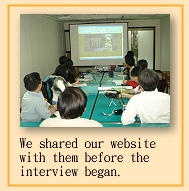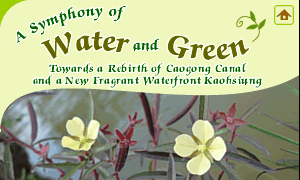 |
Director- general of the
Public Works Bureau
Mr. Hung-mou Wu
¡»Date:13th,Feb,2007 (Tue.)
¡»Location: Kaohsiung Public Works Bureau
¡»Interviewers:Jen-Kai Chang, Yu-Jo Lee, Yu-Ting Chang, Po-Chen Wu
|
|
Although we have been visiting the Public Works Bureau since we began this research and understood the plans regarding the ecological corridor, we did not get the chance to know more about other urban development plans. During this visit, the Director-general of the Public Works Bureau, Mr. Hung-Mou Wu took some time and answered a few questions for us: |
Q¡GWhy do you plan to construct a Wetland Ecological Corridor in Kaohsiung? |
A¡GKaohsiung city had lots of lagoons and wetlands. Yet humans need land, which caused them to disappear. If we don't have enough flood detention ponds, floods will frequently cause disasters. In our urban development plans, we want to transform parks and conservation areas into wetlands. When heavy rain falls down, the water will flow to these places first and prevent floods from happening.Wetlands also provide the birds a place to rest when they fly across this area.
|
Q¡GWhat is the overall plan for the ecological corridor? |
A¡GWe aren't going to make any major changes; we will just use the given landscape and construct a wetland to conserve the animals there. Take Chouchai wetland for example, it used to be farmland, so we breed jacanas there. Yuan-chung Port wetland used for fish breeding purposes, so we developed them into saltwater type wetlands. We sometimes would just expand a little pond into a bigger one, and start from there. Ban-he Village Flood Detention Pond is one example, it used to be a little pond, but we dug and turned it into a detention pond for floods. After the waterways were linked together and the flow began, organisms began to grow as expected. |
Q¡GHow is the Kaohsiung Wetland Ecological Corridor Project promoted? |
A¡G The financing fees are a major subject, we also need the support from our Kaohsiung citizens, which includes students, the government, associations, and everyone. The promoting process is always difficult at first, because some people will start thinking: What's a wetland? Is it just a bunch of weeds that will attract mosquitoes and bugs? Will they affect our living quality? These are all misconceptions of wetlands. Therefore, when we promote the Wetland Ecological Corridor, we have to first come to an agreement with everyone before anything gets started. |
Q¡GWere there any difficulties when you were promoting the wetland ecological corridor project? What were they? |
A¡GA difficult task was to find the water source. Water is everything, especially the source of fresh water. You, I, and organisms all need freshwater. The Kaohsiung area always had good watering systems, but because people need land, they forgot their importance when they were developing the city. Water sources were lost because of this, and this is why your research will be very important in the role of telling people about this fact.
The difference between a gutter and a river is that a river fosters life. It doesn't matter if it is 3, or 30, or 300 meters wide, water with life is considered a river; without life, it's a gutter. I hope that with the future development in underground sewers, river reconstruction, and Eco-technology, we will slowly recover the water systems that we once lost. This is how we can combine nature with our lives.
|
Q¡GWhat are the government plans for the construction of the Waterfront Panorama project? |
A¡GWaterfront Panorama is divided into two phases; the first is directed toward the harbor, the second is directed toward the rivers. The area for construction is large, starting from Hojin Creek, Love River, and water canal No.2 to Cianjhen River. When these "Blue Label" constructions are finished, Kaohsiung city will have a spectacular brand new look. |
Q¡GWhat does the Urban Greening project focus on? |
A¡G"Water"and"Greening"are two important elements of Kaohsiung city, the two combined forms waterfronts flowing with scents of flowers. Kaohsiung has always been considered "Marine City" in Taiwan. So water is closely related to us. With the greening project, we can easily achieve the goal of becoming Waterfront Panorama.
Greening is about a network of plants, we planted many trees on Yisin 2nd Road, SzuWei Road, Wu Fu Road, Minsheng Road, and Ming Chen Road. The trees attracted birds and formed spectacular ecosystems. Our mayor, Chen Chu hopes that another 1.5 million trees will be planted in the future and that the three mountains (Camel Mountain, Bamping Mountain, and Shou Mountain) can also be greened. There are some plans for the greening of open grounds
Most of the greening networks are in construction. For example, Chi-Gean is famous for its seafood, but more trees need to be planted in this area. We think about where we can plant seashore-adaptive plants in this area, and when tourists go eat, they can feel the green as well. Then there is the Tzo-ying Old Gate, Jhongdu pottery area, or True Love Wharf, we try to green as many places as possible. When the "Blue Label"and "Green network"were combined as one, Kaohsiung will be one great city. |
Q¡GWhat does the Green Transportation project focus on? |
A¡GGreen Transportation means a more energy-saving way of transportation. We hope people will walk, ride bicycles or commute by mass trnasportation more often. Another thing we hope for is that people will drive less; once the MRT and mass transportation are in place, people will gradually understand that they can walk or ride bicycles to take the MRT. This is how we can solve the heavy traffic problems.The sidewalks for pedestrians and bicyclers beside the MRT stations will be very beautiful.
This is one of the plans for the Green Transportation project.For instance, if there is a fifty thousand residential community within one mile of a MRT station, we will plant beautiful trees, construct great sidewalks and bicycle paths between them. If there is a school on the way, then they can take in fresh air there if they feel tired. We don't want sidewalks with obstacles every ten meters, that's no good. In the end, we just hope people can use means of mass transportation to commute and walk more often, or they can even use the water system via boats or rafts. |
Q¡GWhat does the Coastal Restoration project focus on? |
A¡GThe Coastal Restoration focuses mainly on the Chi-Gean and Sizihwan Bay. The original Sizihwan Bay area was bigger, but Sun Yat-Sen University needed more land, so the current bay area is a bit smaller. We are constructing two headlands that will finish by the end of this year, we will have 1km and 50m beaches, setting an example and standard for others who wants to do this in the future.
Regarding the Chi-Gean area, the destruction condition is not very serious. We asked the farmers there, the softball court, and the Coast Guard Administration to back up a little more; embankments and headlands can then be built to serve protecting functions. We keep thinking what is best for nature and hope organisms can grow naturally from the beaches. A few more scenery constructions will then be laid out to mimic a natural beach. These are our tasks in the Coastal Restoration project. |
Q¡GWhat does the Theme Park project focus on? |
A¡GIf every park had lots of trees without designing first, it would seem dull. We hope that every park will display differently and create themes in various areas of Kaohsiung city. The Freshwater Park, Birthday Park, and the botanical garden are all famous examples.
|
Q¡GWhat are your expectations for Kaohsiung city in the future during your term of office? |
A¡GAll great cities use large exhibitions to increase their competitiveness and strengthen themselves by building public constructions. Kaohsiung will also follow the footsteps, and prepare for the 2009 Olympics. We shall see that Kaohsiung will have more Wetland Ecological Corridors, green parks, and better living standards. When the MRT, bicycle pathways, and waterways are ready, it will boost Kaohsiung's economy and development rapidly. |
Reflection

The changes in Kaohsiung during recent years are very remarkable. We understood how much work the government has done for these projects after this visit, and will cherish what they have done for us. When we walk on the streets now, we see their efforts everywhere; it feels wonderful to live in this beautiful city, Kaohsiung.
|
|
|

